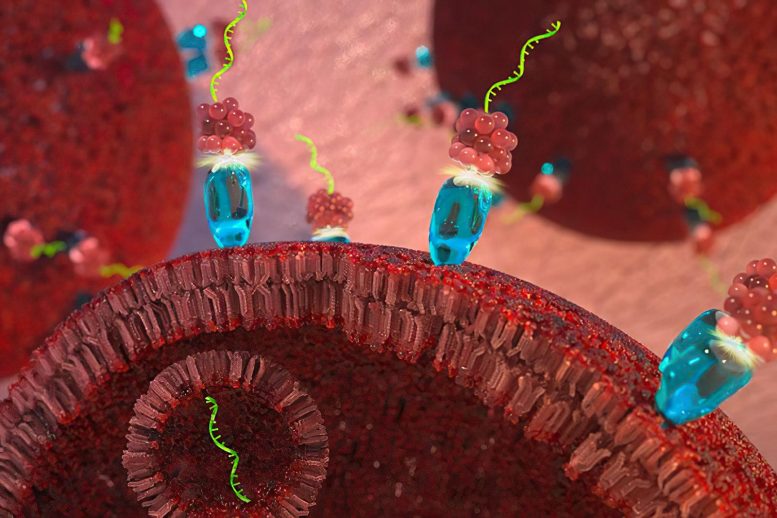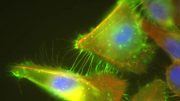
A new therapy targets cancer cells with a modified strand of micro-RNA that naturally blocks cell division. Credit: Second Bay Studios/Purdue University
Researchers from Purdue University have developed a novel cancer treatment that deceives cancer cells into absorbing a snippet of RNA that naturally blocks cell division. A study recently published in Oncogene reveals that over a 21-day period, tumors subjected to this treatment remained unchanged in size, whereas untreated tumors grew threefold.
Cancer can begin almost anywhere in the human body. It is characterized by cells that divide uncontrollably and that may be able to ignore signals to die or stop dividing, and even evade the immune system. The therapy, tested in mouse models, combines a delivery system that targets cancer cells with a specially modified version of microRNA-34a, a molecule that acts “like the brakes on a car,” slowing or stopping cell division, said Andrea Kasinski, lead author and the William and Patty Miller Associate Professor of biological sciences at Purdue University.
In addition to slowing or reversing tumor growth, the targeted microRNA-34a strongly suppressed the activity of at least three genes – MET, CD44, and AXL – known to drive cancer and resistance to other cancer therapies, for at least 120 hours. The results indicate that the patent-pending therapy, the newest iteration in more than 15 years of work targeting microRNA to destroy cancer, could be effective on its own and in combination with existing drugs when used against cancers that have built drug resistance.
“When we acquired the data, I was ecstatic. I am confident that this approach is better than the current standard of treatment and that there are patients who will benefit from this,” said Kasinski, a member of the Purdue Institute for Cancer Research.
MicroRNA-34a is a short double strand of ribonucleic acid – a string of ribonucleic acids attached like the teeth of a zipper along the length of a sugar-phosphate chain. The two strings of the microRNA are unevenly zipped together, with one string acting to guide a protein complex to the worksite in the cell while the other string is destroyed.
In healthy cells, microRNA-34a is abundant, but its presence is dramatically reduced in many cancer cells.
While the idea of reintroducing microRNA-34a to cancer cells appears simple, the research team had to overcome many challenges in crafting an effective therapy. Naturally occurring RNA breaks down rapidly, so to improve the durability of the therapy, the team stabilized microRNA-34a by adding several small clusters of atoms along the length of the strand. The team modeled its modifications on an FDA-approved chemical structure that researchers at the biotechnology company Alnylam used on similar short-interfering RNAs. Experiments on mouse models show the modified microRNA-34a endures for at least 120 hours after being introduced.
As a bonus, the fully modified microRNA-34a is invisible to the immune system, which would ordinarily attack double-stranded RNA introduced to the body.
To ensure the modified microRNA-34a makes it to cancer cells, the team attached the double strand to a molecule of the vitamin folate. The surfaces of all cells in our body have receptors that bind to folate and draw the vitamin into the cell, but the cells in many cancers – breast, lung, ovarian, and cervical – have far more folate receptors on their cell surface than do healthy cells. The tiny microRNA-34a and folate compound penetrates the dense tissue of tumors and binds to the folate receptor on the cell surface. It is then drawn inside in a little bag of cell membrane called a vesicle. Once inside the cell, some of the microRNA-34a is able to escape the vesicle and slows cell division.
The targeted specificity of the therapy reduces the amount of the compound that must be administered to be effective, which in turn reduces potential toxicity, side effects, and cost. The team can also prepare a separate version, which targets a different cell surface receptor, for prostate cancer cells, which do not produce excessive folate receptors. Kasinski and her team are confident in the value of the most recent iteration and will prepare for clinical trials.
Reference: “A first-in-class fully modified version of miR-34a with outstanding stability, activity, and anti-tumor efficacy” by Ahmed M. Abdelaal, Ikjot S. Sohal, Shreyas Iyer, Kasireddy Sudarshan, Harish Kothandaraman, Nadia A. Lanman, Philip S. Low and Andrea L. Kasinski, 5 September 2023, Oncogene.
DOI: 10.1038/s41388-023-02801-8
At Purdue, Kasinski was joined in the research by Philip S. Low, Presidential Scholar for Drug Discovery, Ralph C. Corley Distinguished Professor of Chemistry, and inventor of the FDA-approved drug Cytalux; Nadia A. Lanman, a research assistant professor; Ahmed M. Abdelaal, first author and a graduate student in Kasinski’s lab; and researchers Harish Kothandaraman, Kasireddy Sudarshan, Shreyas Iyer and Ikjot S. Sohal.
The study was funded by the National Institutes of Health and the Department of Defense.
Kasinski disclosed the innovation to the Purdue Innovates Office of Technology Commercialization, which has filed a patent application on the IP. Industry partners interested in developing or commercializing the work should contact Joe Kasper, assistant director of business development, [email protected].









I have Breast Cancer, can you please call me at 818 358-9722. I would like to see your Dr/drs offering this treatment.